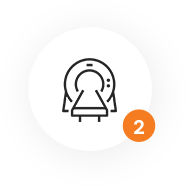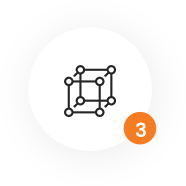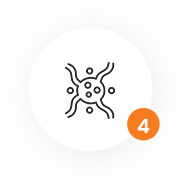This is a preview of our website! We are currently still in research and development and solving specific challenges to be able to actually offer what we talk about here.
Update December 22, 2026: This year was eventful. We are closer to our goal than ever before. Check back here regularly for news!
We offer a targeted, effective and safer
CANCER
TREATMENT
TREATMENT
Ambrego's individualized treatment induces cell-cycle arrest only on cancerous cells, allowing the far safer Ambrego treatment to completely replace the conventional chemotherapy. Also, Ambrego's treatment actively destroys cancerous cells. Given as a supplement to conventional chemotherapy, it can turn a palliative chemotherapy treatment into an effective treatment which cures the patient. Suitable for both humans and animals.
We offer a targeted, effective and safer
CANCER
TREATMENT
Ambrego's individualized treatment induces cell-cycle arrest targeted only on cancerous cells, allowing the far safer Ambrego treatment to completely replace the conventional chemotherapy. Also, Ambrego's treatment actively destroys cancerous cells. Given as a supplement to conventional chemotherapy, it can turn a palliative chemotherapy treatment into an effective treatment which cures the patient. Suitable for both humans and animals.
How The Treatment Improves
on the prior state of the art

Chemotherapy not only acts on cancerous cells, but also other fast-dividing cells such as hair follicles and bone marrow. Many patients can accept the massive side effects, however for others the resulting side effects are straight-out dangerous (children, persons with pre-existing conditions). Due to the targeting, these side effects do not exist with the Ambrego therapy.
> Safer but just as effective replacement to chemotherapy for high risk patients
In contrast to chemotherapy which only induces cell-cycle arrest, one component of the Ambrego therapy actively destroys cancerous cells (induces apoptosis). Given as a supplement to conventional chemotherapy, it can turn a palliative chemotherapy treatment into an effective treatment which cures the patient.
> Effective cure for many situations where conventional chemotherapy alone no longer cures the patient


The individualized drugs actively target the cells by recognizing the DNA mutations themselves. No prediction or profiling, which per definition is inaccurate, as with individualized immunotherapy, no interpretation of the DNA mutations.
> Ultra targeted, resulting in higher efficacy and fewer side effects.
Prior treatment, the effectiveness of the individualized drugs is tested in-vitro with the patient's cell samples, then in patient's body with MRI marker drugs which use the same targeting mechanism as the active drugs.
> No time is lost with ineffective treatments.


If the tests prior treatment show that the individualized drugs are not effective due to being immune to the proteins expressed or genes silenced, they can be easily changed to target other signalling pathways in the cell.
> Thus a high chance for success even if the tumor does not respond to other treatments.

Chemotherapy not only acts on cancerous cells, but also other fast-dividing cells such as hair follicles and bone marrow. Many patients can accept the resulting side effects, however for others the resulting side effects can be straight-out dangerous (children, persons with pre-existing conditions). Due to the targeting, these side effects do not exist with the Ambrego therapy.
> Therefore, far fewer dangerous side effects.

In contrast to chemotherapy, Ambrego therapy does not have to take into account healthy cells, which are also attacked. Thus, the individualized drugs can be fine tuned for far effectiveness towards the cancerous cells.
> Therefore, much higher efficacy.

The individualized drugs actively target the cells by recognizing the DNA mutations themselves. No prediction or profiling, which per definition is inaccurate, as with individualized immunotherapy, no interpretation of the DNA mutations.
> Again, higher efficacy and fewer side effects.

Prior treatment, the effectiveness of the individualized drugs is tested in-vitro with the patient's cell samples, then in patient's body with MRI marker drugs which use the same targeting mechanism as the active drugs.
> No time is lost with ineffective treatments.

If the tests prior treatment show that the individualized drugs are not effective due to being immune to the proteins expressed or genes silenced, they can be easily changed to target other signalling pathways in the cell.
> Thus a high chance for success even if the tumor does not respond to other treatments.
The Treatment Process
Manufacturing of the drugs (4-6 weeks)
01
The oncologist does a biopsy of the tumor(s), and also harvests samples of healthy cells from the patients.
02
The samples are shipped to Ambrego in Düsseldorf, Germany.
03
Using whole genome sequencing techniques, Ambrego detects DNA mutations which best seperates the healthy from the cancer cells.
04
Ambrego produces 4 drugs which have an effect only on cells with the DNA mutations (cancerous cells):


one to mark cells with eGFP (visible in microscope)
one to mark cells with MRI contrast substance


one to induce cell-cycle-arrest (meaning: inhibits cell growth)
one to initiate apoptosis (meaning: destroys cells)




one to mark cells with eGFP (visible in microscope)
one to mark cells with MRI contrast substance
one to induce cell-cycle-arrest (meaning: inhibits cell growth)
one to initiate apoptosis (meaning: destroys cells)
05
Ambrego verifies with the drug 1 in-vitro (meaning: in a petri dish) that the mutations split the two cell samples of the patient (healthy and cancerous cells) correctly. If not, drugs targeting other mutations are produced.
06
Ambrego verifies with drug 3 and drug 4 in-vitro that the cancerous cells respond to the active ingredients expressed on cancer cell detection. If not, drugs with alternative active ingredient targeting other cell pathways are produced.
07
Ambrego ships drugs 2, 3 and 4 to the oncologist.
08
Use drug 2 and a subsequent full body MRI scan, the oncologist checks whether the cancerous cells are precisly targeted.
The actual treatment
The goal of the Ambrego treatment is to cure cancer in a controlled manner. There are no treatment cycles in which a combination of drugs is administered and the body then has to recover for a longer time, as with conventional chemotherapy.
As part of the Ambrego treatment, one drug is used to put the cancer cells into constant cell cycle arrest, meaning the cancer cells can no longer divide and therefore grow. With another drug, the cancer cells are destroyed, but, as there is no race to combat cancer growth, only at a pace that does not overwhelm the patient.
The patient has a good chance of living a normal life during the treatment and of being cured at the end of the treatment.




